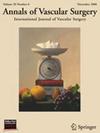Endovascular Aneurysm Repair with Zenith Alpha Abdominal Stent-Graft in Hostile and Nonhostile Aortic Neck Anatomies
IF 1.4
4区 医学
Q3 PERIPHERAL VASCULAR DISEASE
引用次数: 0
Abstract
Background
The aim of this study was to evaluate early and 5-year outcomes of endovascular aneurysm repair (EVAR) with Zenith Alpha Abdominal in the context of a multicenter regional retrospective registry comparing patients with hostile and nonhostile aortic necks.
Methods
A retrospectively maintained dataset identified all consecutive patients with Abdominal Aortic Aneurysms underwent elective EVAR with implantation of a Zenith Alpha Abdominal in 7 centers between January 2016 and December 2022. Two-hundred-twenty-eight patients have been included in the present study: 98 (43%) with a hostile neck (Group HN), and 130 (57%) with a no-hostile neck (Group n-HN). Early (30-day) outcomes in terms of technical and clinical successes were assessed and compared. Estimated 5-year outcomes were evaluated and compared in terms of survival, freedom from type I/III endoleak, freedom from surgical conversion, freedom from limb graft occlusion, and freedom from any device-related reintervention(s) by using life-table analysis (Kaplan-Meier curves) and log-rank test.
Results
Female gender was more frequent in Group HN (15.3% vs. 5.3%, P = 0.01). Thirty-day technical success rate was 96.9% in Group HN, and 100% in Group n-HN (P = 0.08), while 30-day clinical success rate was 96.9% in Group HN, and 99.2% in Group n-HN (P = 0.21). Overall median follow-up period was 32.1 months [InterQuartile Range 14–47]. Estimated 5-year survival rates were comparable (67.1% in Group HN, and 77.9% in Group n-HN, P = 0.47). During the follow-up no endoleak type III have been detected in both groups. At 5 years there were no differences between the two groups in terms of freedom from surgical conversion (95.1% Group HN vs. 96.7% Group n-HN; P = 0.71, log-rank 0.14), freedom from limb graft occlusion (95.7% Group HN vs. 93.5% Group n-HN; P = 0.58, log-rank 0.29), and freedom from any device-related reintervention(s) (70.5% Group HN vs. 89.7% Group n-HN; P = 0.19, log-rank 1.72). Starting from the third year of follow-up, hostile neck affected type I endoleak rate (70.2% Group HN vs. 98.4% Group n-HN; P = 0.008, log-rank 6.96). Female gender was the only factor affecting type I endoleak onset during the follow-up (P = 0.02; log-rank = 5.44).
Conclusion
In the present multicenter experience hostile neck was more frequent in female patients. Hostile neck affected type I endoleak rates in patients undergoing Zenith Alpha Abdominal implantation starting from the third year of follow-up from the index procedure.
求助全文
约1分钟内获得全文
求助全文
来源期刊
CiteScore
3.00
自引率
13.30%
发文量
603
审稿时长
50 days
期刊介绍:
Annals of Vascular Surgery, published eight times a year, invites original manuscripts reporting clinical and experimental work in vascular surgery for peer review. Articles may be submitted for the following sections of the journal:
Clinical Research (reports of clinical series, new drug or medical device trials)
Basic Science Research (new investigations, experimental work)
Case Reports (reports on a limited series of patients)
General Reviews (scholarly review of the existing literature on a relevant topic)
Developments in Endovascular and Endoscopic Surgery
Selected Techniques (technical maneuvers)
Historical Notes (interesting vignettes from the early days of vascular surgery)
Editorials/Correspondence

 求助内容:
求助内容: 应助结果提醒方式:
应助结果提醒方式:


